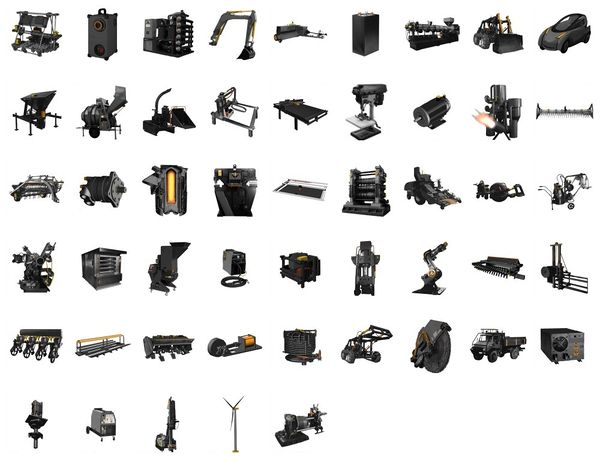Global Village Construction Set: Difference between revisions
m (→Examples) |
(reorder text: high-level to low-level) |
||
| Line 4: | Line 4: | ||
The '''[[Global Village Construction Set]]''' (GVCS) is a modular, DIY, low-cost, high-performance platform that enables fabrication of the 50 different Industrial Machines that it takes to build a small, sustainable civilization with modern comforts. The name, GVCS, has been coined for the first time in 2008 - at a lecture at the University of Missouri, Columbia - see [[UM Presentation]]. | The '''[[Global Village Construction Set]]''' (GVCS) is a modular, DIY, low-cost, high-performance platform that enables fabrication of the 50 different Industrial Machines that it takes to build a small, sustainable civilization with modern comforts. The name, GVCS, has been coined for the first time in 2008 - at a lecture at the University of Missouri, Columbia - see [[UM Presentation]]. | ||
== Media == | == Media == | ||
| Line 58: | Line 41: | ||
|} | |} | ||
== GVCS Machines == | |||
OSE is developing 50 machines of the Global Village Construction Set via module-based design. This means that we break machines down into modules, and each module can be developed in parallel with other modules. Examples are [[CEB Press]] or [[Tractor]]. | |||
The exact list of GVCS machines has evolved over time and is still subject to change. For example, while the [[MicroHouse]] and the [[Car]] are not GVCS machines in a strict sense (but products created by GVCS machines), they are treated as GVCS machines for historical and business-oriented reasons. | |||
Documentation is found at different places for different target groups: | |||
* Graphical list of 50 machines on our [http://opensourceecology.org/gvcs/ main website] (Public) | |||
* Hierarchical representation of machines/modules at dozuki: http://opensourceecology.dozuki.com/ (Public, Prototypers, Developers) | |||
* Wiki internal list of GVCS machines and their breakdown into modules - [[GVCS Machines and Modules]] and [[GVCS State of Completion]] (Prototypers, Developers) | |||
The master reference for GVCS machines and names is the GoogleDoc https://docs.google.com/spreadsheet/ccc?key=0AkNG-lv1ELQvdGYycGFSMjYtODlZcFROcHZ2NjBwNEE&usp=drive_web#gid=3 as included in [[GVCS State of Completion]]. | |||
As of 2015-01-30, the idea is to keep the wiki slightly unstructured and visualize the hierarchical structure of machines/modules in dozuki. This process is in progress. | |||
<span style="color: #f00">Warning: As of 2015-01-30, all three data sources are different (different names or sets). Also, the following list is not up-to-date.</span> | |||
== List of GVCS machines == | == List of GVCS machines == | ||
{{GVCS_List}} | {{GVCS_List}} | ||
Revision as of 18:54, 1 February 2015
Definition
The Global Village Construction Set (GVCS) is a modular, DIY, low-cost, high-performance platform that enables fabrication of the 50 different Industrial Machines that it takes to build a small, sustainable civilization with modern comforts. The name, GVCS, has been coined for the first time in 2008 - at a lecture at the University of Missouri, Columbia - see UM Presentation.
Media
Key Features
See summary at OSE Specifications for Product Design.
|

|
GVCS Machines
OSE is developing 50 machines of the Global Village Construction Set via module-based design. This means that we break machines down into modules, and each module can be developed in parallel with other modules. Examples are CEB Press or Tractor.
The exact list of GVCS machines has evolved over time and is still subject to change. For example, while the MicroHouse and the Car are not GVCS machines in a strict sense (but products created by GVCS machines), they are treated as GVCS machines for historical and business-oriented reasons.
Documentation is found at different places for different target groups:
- Graphical list of 50 machines on our main website (Public)
- Hierarchical representation of machines/modules at dozuki: http://opensourceecology.dozuki.com/ (Public, Prototypers, Developers)
- Wiki internal list of GVCS machines and their breakdown into modules - GVCS Machines and Modules and GVCS State of Completion (Prototypers, Developers)
The master reference for GVCS machines and names is the GoogleDoc https://docs.google.com/spreadsheet/ccc?key=0AkNG-lv1ELQvdGYycGFSMjYtODlZcFROcHZ2NjBwNEE&usp=drive_web#gid=3 as included in GVCS State of Completion.
As of 2015-01-30, the idea is to keep the wiki slightly unstructured and visualize the hierarchical structure of machines/modules in dozuki. This process is in progress.
Warning: As of 2015-01-30, all three data sources are different (different names or sets). Also, the following list is not up-to-date.
List of GVCS machines
Resolve naming inconsistencies
(for simplicity, I put this section on the page itself. please move it to the talk page if you think that's more appropriate) Nathanael Wettstein (talk) 00:50, 31 January 2015 (CET)
TODO: Replace this section with "machine naming conventions" as soon as they exist.
General points
- We need consistent names for the machines over all databases and communication channels.
- Proposal: Introduce a fixed numbers for each machine (e.g. "GVCS Machine #001: CEB Press") which allows identification when the name changes. This seems to happen a lot during development (e.g. LifeTrac, The Liberator).
Details (UPPERCASE is name from GoogleDocs, MixedCase from OSE website)
- IRONWORKER vs. Ironworker Machine
- CNC TORCH TABLE vs. CNC Torch/Router Table
- SOIL PULVERIZER vs.Rototiller and Soil Pulverizer
- SOLAR CONCENTRATOR vs. Linear Solar Concentrator
- WIND TURBINE vs. 50 kW Wind Turbine -- Proposal: Do not put technical specs into machine names
- ALUMINUM EXTRACTOR vs. Aluminium Extractor from Clay
- CHIPPER + HAMMERMILL vs. Chipper/Hammermill
- ELECTRIC MOTOR + GENERATOR vs. Electric Motor/Generator
- NICKEL IRON BATTERIES is consistent, but why a plural? -- Proposal: Use singular everywhere
- Why do some machines have "Open Source" or "machine" in their names? Aren't all machines supposed to be open source? Can we just strip that?
- The reference document should use MixedCase to make the correct spelling visible (e.g. MicroHouse). Who can edit that document? May I?
@Marcin: How to resolve these inconsistencies?